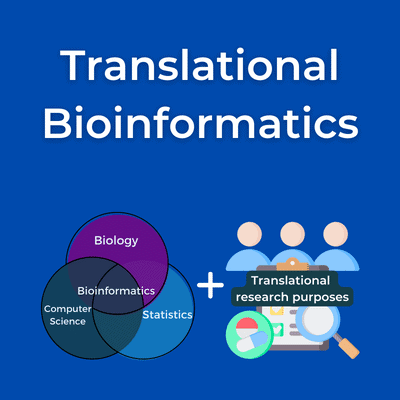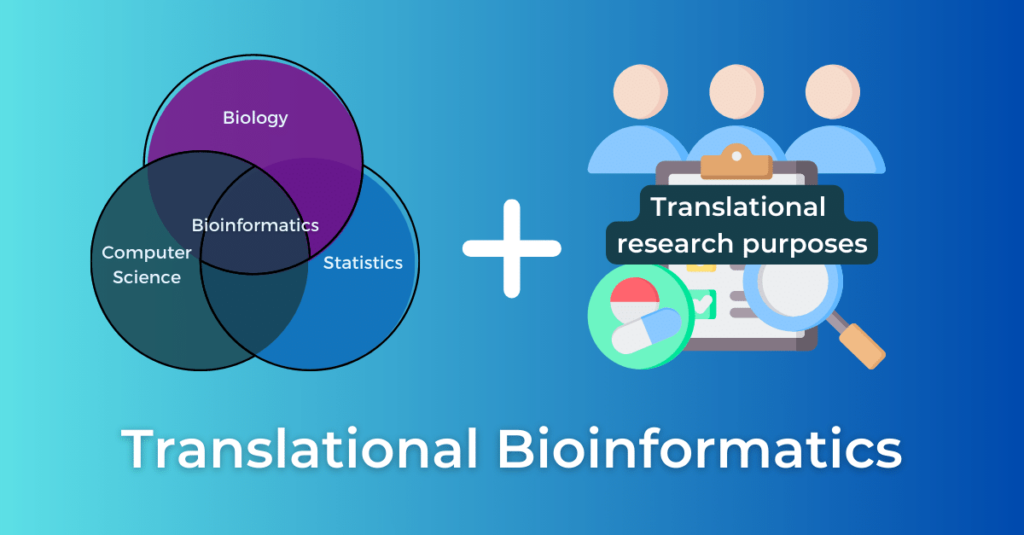Translational Bioinformatics: Advance Your Clinical Research
- 9th August 2023
- Posted by: Breige McBride
- Category: Bioinformatics

Translational bioinformatics significantly impacts clinical research and is extremely useful for translational scientists. This blog explains why. First, however, we will explain the difference between bioinformatics and translational bioinformatics.
What is bioinformatics?
Bioinformatics is basically big data analysis for biological data. Bioinformaticians use computational and statistical analyses to find meaning in biological data, revealing insights that advance research in everything from drug discovery to agriculture. Simply put, bioinformatics is a combination of biology, computer science, and statistics.
What is translational bioinformatics?
Translational bioinformatics is an important subfield of bioinformatics. It is defined as “the union of translational medicine and bioinformatics” that “makes it possible to access the knowledge of scientific evidence and apply it to clinical practice”1. It specifically focuses on analysing biological data to drive clinical research discoveries and clinical decision-making. Clinical trials, in particular, can benefit immensely from this type of bioinformatics.

What is the difference between bioinformatics and translational bioinformatics?
Bioinformatics involves the analysis of biological data for any purpose, and the term ‘bioinformatics’ can also refer to the development of methods or software for understanding biological data. Translational bioinformatics, however, refers to bioinformatic analyses which are used specifically to advance clinical research. Just as translational science centres on translating scientific research and discoveries into practical applications to improve health outcomes, translational bioinformatics refers to bioinformatic analyses used for the same purpose.
What is an example of translational bioinformatics?
Any time we use bioinformatics analyses to search biological data for insights, with the goal of translating these insights into a practical application to improve health, we can consider this an example of translational bioinformatics. One specific example would be analysing clinical trial data to determine the mode of action of a drug. In fact, you can see how our bioinformaticians did exactly that in this case study. Determining the mode of action of a drug helps with things like determining the optimal drug dosage or stratifying patients. You can view more translational bioinformatics examples on our case study and publications pages.
How does translational bioinformatics advance clinical research?
Translational bioinformatics advances clinical research in a variety of ways. By analysing, and often integrating, large and diverse biological data sets, translational bioinformatics reveals a variety of different insights that further clinical research. These include insights such as identifying biomarkers, determining compound modes of action, and assessing a drug’s toxicity. Such insights can improve diagnostics, inform clinical decision-making and accelerate drug development research.
Our solutions for Translational Scientists
If you want to advance your translational research quickly and efficiently, Fios can certainly help! We can integrate and analyse any biological data you have gathered so far to reveal the relevant insights to inform your next steps. What’s more, we can identify and analyse public domain data that is relevant to your research to provide additional insights or validate your research findings. Learn more about our clinical data analysis capabilities.
Why work with Fios Genomics?
Our bioinformaticians have the biological knowledge not only to understand your research but also how important it is. As a company, we take great pride in our work and the part we play in advancing health research. This, coupled with our excellent interactive bioinformatics analysis reports, has made us the bioinformatics provider of choice for over 240 companies. With a 95% repeat business rate, we are certainly getting something right! You can discover what clients think we do well by viewing our client testimonials.
Sources
1 Casotti, M.C.; Meira, D.D.; Alves, L.N.R.; Bessa, B.G.d.O.; Campanharo, C.V.; Vicente, C.R.; Aguiar, C.C.; Duque, D.d.A.; Barbosa, D.G.; Santos, E.d.V.W.d.; et al. Translational Bioinformatics Applied to the Study of Complex Diseases. Genes 2023, 14, 419. https://doi.org/10.3390/genes14020419
Author: Breige McBride, Content and Social Media Manager, Fios Genomics
Reviewed by Fios Genomics Bioinformatics Experts to ensure accuracy
You may also be interested in:
Bioinformatics 2024: Predictions and Challenges
Examples of Biomarkers and Biomarker Data Analysis
Using Biobank Data to Reach Your Research Goals
Leave a Reply
You must be logged in to post a comment.

